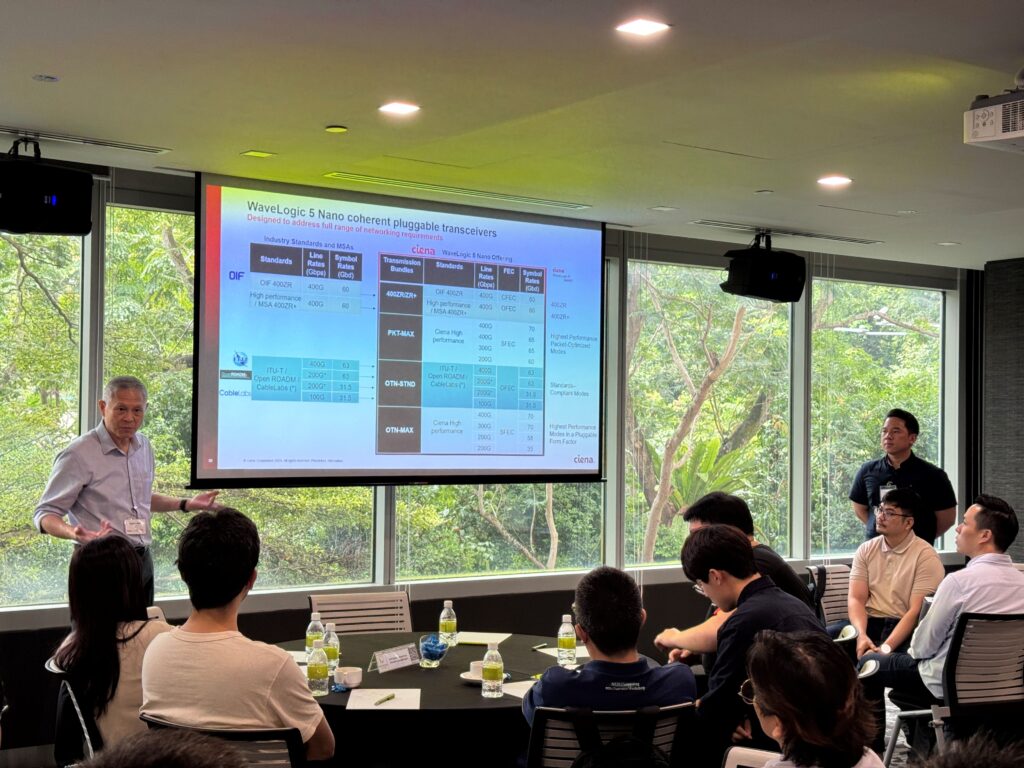Beyond 400G: Optical Networking’s Next Wave at the Ciena Master Class – 8 Apr 2025
17 April 2025 – On April 8, 2025, SingAREN, in collaboration with Terrabit Networks Pte. Ltd. and Ciena, hosted a Ciena Master Class for over 20 SingAREN members at the Park Avenue Rochester Hotel. The event fostered a dynamic exchange of information among all participants.

Figure 1 Participants and organisers for this Master Class
During the Master Class, members discussed their network architectures and the challenges their institutions face. For example, NUS CREATE shared how they overcame NUS infrastructure constraints by leveraging SingAREN’s help to construct a VXLAN. An NTU member highlighted that the increasing use of high-resolution scientific instruments and the growing adoption of AI are straining their campus network capacity. Participants also engaged in discussions about quantum-safe technologies, including QKD and PQC.
SingAREN’s optical DWDM backbone utilizes Ciena 6500 optical solution to provide connectivity to member institutions such as NUS, NTU, and A*STAR. This backbone supports 10G and 100G connections and ensures seamless service to users with a 50-millisecond cutover in case of link failure. SingAREN’s primary focus is on the optical DWDM backbone layer, with less emphasis on G-PON, which is considered a campus-wide solution.
Ciena’s sales engineering experts, Gideon Hoe, and Markus Chua, presented Ciena’s vision and solutions for the next generation of optical networks, addressing the challenges and opportunities driven by the ever-increasing demand for higher speed connectivities.

Figure 2 Engaging sessions from the participants to Ciena experts – Gideon Hoe (left – standing), Markus Chua (right – standing)
Key Topics Discussed
The Master Class covered several key topics:
-
- High-Speed Optical Transmission: Gideon and Markus discussed advancements in optical transmission technologies, including the move towards higher speeds (1.6T) and greater capacity to support data-intensive applications. This involves advancements in coherent optical solutions, including pluggable transceivers, to maximize fiber capacity and reduce cost per bit.
- Network Architecture and Convergence: The discussion emphasized the need for a unified network architecture spanning from access to core and subsea, to enable seamless connectivity and efficient traffic management. The convergence of IP and optical layers was highlighted as a key theme, with technologies like coherent routing and IP/MPLS for streamlining network operations.
- Access Network Evolution: The presentation addressed the transformation of access networks, focusing on PON technologies (XGS-PON) for delivering higher bandwidth to users and campuses. The trend towards more compact and efficient solutions, such as pluggable micro OLTs to save space and power, was also discussed.
- Software Control and Automation: The importance of software-defined networking (SDN), automation, and network control was underscored. The use of telemetry, analytics, and AI/ML for network monitoring, optimization, and proactive management was highlighted.
- Network Efficiency and Sustainability: The need to reduce space and power consumption in network deployments was a recurring topic, driven by cost considerations and green initiatives.
SingAREN plays a crucial role in facilitating high-speed international connectivity, serving as a regional hub with connections to Europe, Japan, and the US. SingAREN has recently upgraded to 400G switches with pluggable 400G ZR transceivers to support 400G international connections. This option proves to be a cost-effective and scalable solution while reducing power consumption, improving operational efficiency, and simplifying network architecture.
The Ciena Master Class successfully brought together industry, research, and education to address the growing demands of the digital age. SingAREN extends its gratitude to Gideon Hoe, Markus Chua, and Ang Yeow Chong from Ciena, as well as Selina Chan and Sebastian Mock from Terrabit Networks, for their contributions to the session. We also thank all the participants for their involvement in the workshop.


